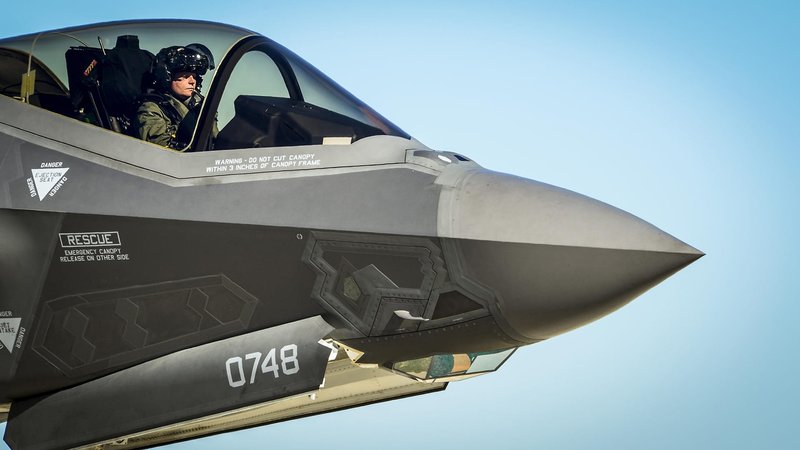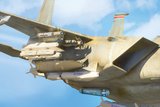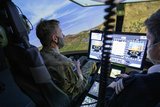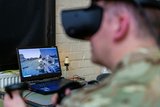How open avionics are enabling the next generation of air dominance (Studio)
Brought to you in partnership with Collins Aerospace
The fight of tomorrow demands a more open, scalable and tailorable approach to aircraft upgrades to stay ahead of emergent threats at the speed of relevance.
The United States and its allies must maintain a competitive edge against adversaries by leveraging enabling technologies that accommodate the need for enhanced mission flexibility, rapid prototyping, capability integration and deployment.
The Importance of an Open Systems Approach
In response to that challenge, the U.S. Department of Defense (DoD) has been working to accelerate the development of and upgrades to its weapons and vehicles to ensure mission readiness while lowering the lifecycle costs to maintain and evolve them.
This process has involved a strong focus on moving away from purpose-built systems created for a single aircraft or vehicle platform to reusable components and systems integrated in a modular and severable fashion.
To facilitate this process, the DoD is requiring its industry partners to embrace an open systems approach – creating systems that can quickly integrate capabilities from a variety of vendors into new or enduring platforms to enable the warfighter to stay ahead of a next-generation adversary that is rapidly evolving its capability with scale in both crewed and uncrewed assets.

A Modular Open Systems Approach (MOSA) is a viable method for developing the same systems or software repeatedly for multiple platforms without having to pay for them separately or reinvent the wheel each time the military builds a new aircraft, ground vehicle, or other weapons system.
MOSA systems also better enable the rapid addition of new functionality and capabilities into legacy and enduring platforms at a low cost to the military, thereby providing more budget allowances for emerging mission capabilities needed for future conflicts.
Finally, this open systems approach, and the standardization parameters it entails for aircraft integration, eliminates the common situation known as “vendor lock” in which only one or two companies can develop or integrate new capabilities and systems for an aircraft.
In effect, fighter fleet owners are empowered to make changes to the systems and aircraft with enabling software and hardware tools for easy parts interchange. This means that open systems can effectively increase competition as more suppliers compete for business – leading to lower costs and driving innovation.
Bringing Open and Networked Capabilities to Next-Generation Fighters
So how will these new MOSA capabilities impact future operations and the U.S.’s ability to achieve air dominance?
By implementing an agile and adaptable suite of avionics and mission solutions, future fighter fleets will be more reliant on software upgrade packages that can be delivered enroute to the mission compared with traditional, timely and expensive aircraft and fleet upgrade cycles. Consequently, enduring and next-generation aggressor fleets will remain tailorable, relevant and dominant in the missions of tomorrow.
At Collins Aerospace, the company’s modern operational expertise and commitment to innovation are driving its development of next-generation systems for fighter aircraft.
With its decades of experience in emerging network technologies and standards, Collins is taking an operations focus on developing robust, open and networked capabilities across existing and sixth-generation fighter aircraft to address future threats and provide air superiority in theatre.
Mosarc Delivers Modular, Open, Scalable and Secure Architectures
Known as Mosarc™, Collins’ modular, open, scalable, and secure avionics and platform architecture will help ensure an agile and flexible sixth-generation fighter by providing whatever capability is needed based on mission demands.
This will be accomplished through Mosarc’s revolutionary digital backbone that meets open systems standards and ensures the separation of air vehicle and mission system equipment while managing the exchange of information between the two.
The operational benefit manifests in increased performance (e.g., data throughput), safety, cybersecurity and the intelligent prioritization of aircraft data transfer while performing complex and contested mission sets.
Leveraging Collins’ Mosarc solutions and MOSA compliant design, future fighter fleets will be enabled to:
- Rapidly field mission-critical capability to provide innovation at the speed of relevance
- Maximize mission and platform flexibility while reducing integration time and aircraft lifecycle costs
- Reduce supply chain risk and protect previous investments
In addition, Collins remains committed to defining, designing and evolving its Mosarc open system capabilities in alignment with emerging standards (e.g., OMS, HOST, FACE™, SOSA™) for rapid integration between mission and flight deck systems.
With 30 years of experience in developing and integrating open systems avionics in military and commercial cockpits, Collins Aerospace closely aligns its investment and research roadmaps with the evolving needs of fourth-, fifth- and sixth-generation fighter aircraft operators.
It remains the industry leader in developing and certifying safety critical systems while ensuring rapid capability deployment and continued air dominance of the DoD and its allies.
More information is available here
More from Studio
-
![Combat-proven capabilities: How precision-strike systems are evolving for tomorrow’s battlespace (podcast)]()
Combat-proven capabilities: How precision-strike systems are evolving for tomorrow’s battlespace (podcast)
Combat-tested technology is being reshaped to counter A2/AD threats, reduce reliance on GPS and enable faster, more autonomous targeting in complex environments. In this special podcast, experts explain how the evolving threat landscape is shaping next-generation strike capabilities.
-
![Energy evolution: How laser defence systems are powering the next phase of air defence (podcast)]()
Energy evolution: How laser defence systems are powering the next phase of air defence (podcast)
Laser-based air defence is moving from promise to deployment as global threats evolve. In this special podcast, we explore how high-energy laser systems are reshaping interception strategies.
-
![Intelligence advantage: How real-time GEOINT is reshaping military decision-making (Studio)]()
Intelligence advantage: How real-time GEOINT is reshaping military decision-making (Studio)
In today’s contested operational environment, adaptability is key. The new Geospatial-Intelligence as a Service (GEO IaaS) solution from Fujitsu and MAIAR empowers militaries by enabling intelligence advantage, combining advanced technology with human expertise to deliver actionable insights.
-
![Training Together: Unlocking Educational Excellence through Military and Industry Collaboration (Studio)]()
Training Together: Unlocking Educational Excellence through Military and Industry Collaboration (Studio)
Military training is ultimately about people. At Capita, training programmes are built on close engagement with partners, delivering an educational approach that can adapt to individual needs, cultivate leadership – and drive wider cultural change.
-
![Enhancing Military Training Through Digital Technology (Studio)]()
Enhancing Military Training Through Digital Technology (Studio)
Digital technologies offer huge opportunities for defence training. However, militaries must adopt an agile approach, placing the needs of their organisations and personnel at the centre of their efforts.
-
![Layered Defence: How new technologies are enhancing armoured vehicle survivability and manoeuvrability (Studio)]()
Layered Defence: How new technologies are enhancing armoured vehicle survivability and manoeuvrability (Studio)
As modern threats evolve, armoured fighting vehicles face a new era of challenges, from loitering munitions to kinetic energy projectiles. Advances in active, passive, and reactive protection systems are crucial to ensuring battlefield dominance, freedom of manouver and vehicle survivability.






















